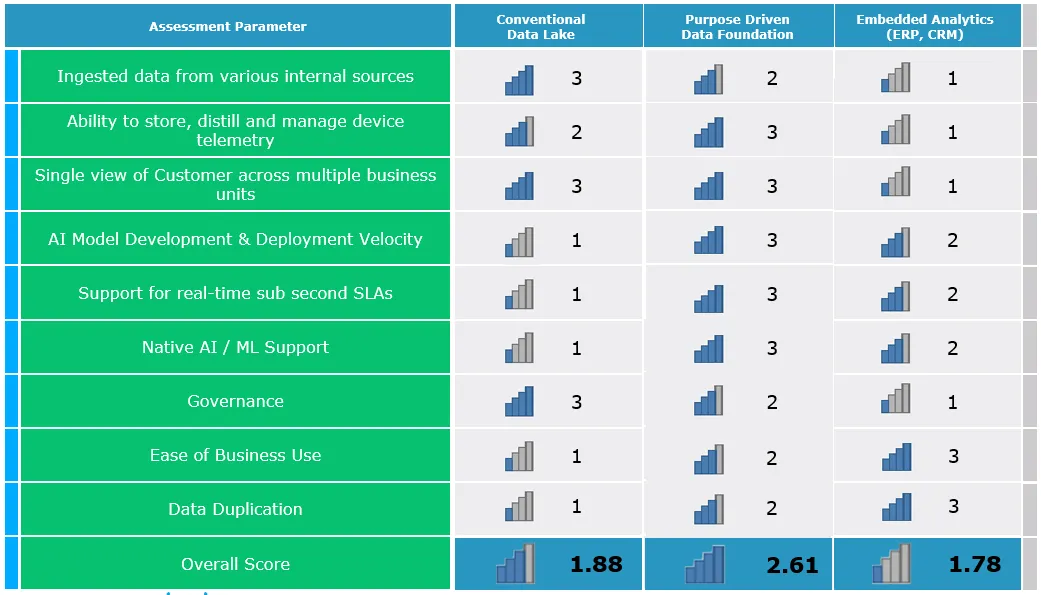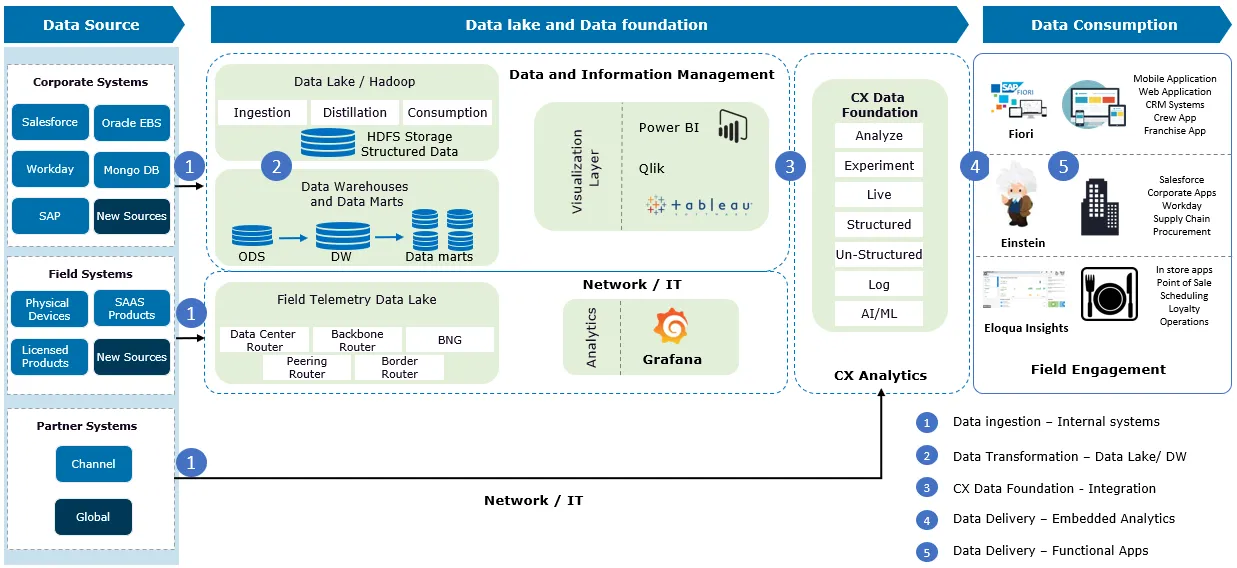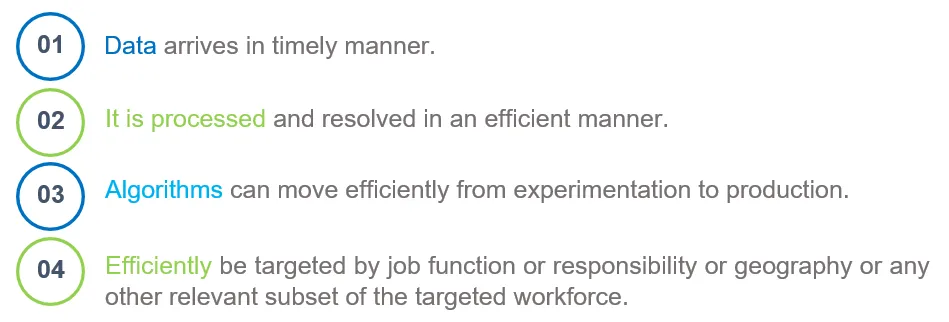Accelerating the customer experience (CX)
Blog: Capgemini CTO Blog
Introduction
Customer obsession and delivering the best customer experience (CX) are key to growth, renewals, and profits. Catering to ever-changing customer needs requires an agile data foundation. An agile data foundation improves field velocity while allowing the organization to infuse its purpose through data-driven recommendations that support the field force.
For customer success to be effective and adopted by the field, it must be timely and in context. Timeliness could mean anything from “next day” to “in the moment” (seconds or minutes after an action). Context means tailoring the decisions/recommendations/metrics to the type of sale, industry, geography, and seasonality/other time dimension. If neither time nor context are addressed, the recommendation and KPIs may fall out of use due to pushback from the field. Finally, the system/platform needs to be flexible. KPIs and metrics created at headquarters often require field customization to address blind spots and unintended consequences. Incorporating this level of dynamism allows the platform and process to be adopted and drive business value.
Customer success and sales functions at high-tech companies are quite complex (sales are enabled by direct sales teams, partners, resellers, etc.). The field traverses many verticals, across many customers and their revenue segments, and many different classes of products: from hardware, to embedded systems, to licensed software, to SaaS components.
Designing and evolving field-impacting and field-adopted metrics can be challenging. This results in many companies moving fast – having speed – but not making achieving great CX, i.e. not having velocity (in other words, lacking direction). A key metric we call the “deployment rate” is how we measure R&D yield. A low deployment rate indicates an environment where ideas may be forthcoming at great speed but may have little velocity as they may be stuck in a PoC trap or have some other circumstance that leads to a small percentage of experiments making it to field adoption. A low deployment rate often has a high correlation to high cost and low value from experimentation.
Increasing the deployment rate requires two key vectors. The first vector is a high-velocity process that allows close collaboration between the CX, CX data and analytics teams and the field teams. The second vector is a highly efficient data foundation architecture where:

The ROI can easily be computed and tracked as a whole and on any applicable subset.
Customer experience will be a key differentiator in near future and organizations geared in this direction will have a competitive edge in retaining and expanding customer relationships. To build the right Customer 360 Data foundation, we need to consider the following themes to design and enhance the Customer experience platform:
- Customer purchase history: Understand purchasing patterns
- Agility and automation: Better engagement through smart technologies
- Vendors and partner enablement: Share analytical capabilities around customer data
- Product telemetry: Multi-dimensional telemetry data on product utilization, consumption, and deployment rates
- Pricing: Product pricing against the competition landscape.
Architecture patterns
To accelerate delivery of advanced analytics to various personas, having the right data foundation and right deployment architecture is paramount. Three types of architectures that deliver various levels of outcome acceleration for advanced recommendations and analytics are:

Each of these architecture patterns has its strengths and is best suited for specific business cases. A comparative analysis of the four types of architectures on various parameters – data congregation from disparate sources to delivering advanced AI/ML capabilities – illustrates application of these data architecture patterns to real-world scenarios
Comparison of the three data foundation patterns for various assessment parameters:

Pattern 1: Conventional data lake environment
This is a data lake environment built using a traditional set of tools and technologies, where end-user recommendations are delivered to a CRM platform such as SFDC. The architecture pattern for a conventional data lake environment is illustrated below:

Key highlights of the conventional data lake architecture:
- Data is ingested into a secure, industrialized, optimized, and automated platform (automation and DevOps tooling)
- Product telemetry ingested into NoSQL or any IoT database
- Data is processed through a data governance layer, which extends across the layers of the architecture
- Data is held as part of the data lake, transformed, and stored as a part of a data-centric layer
- Data transformed and data engines, presenting business products or as schematics/virtual view of data
- Data mining, data science, and ML enable predictive and prescriptive and adaptive analytics
- AI provides breakthroughs in automating and transforming human and machine tasks.
This architecture pattern accelerates CX analytics delivery through:
- Ability to build comprehensive, 360-degree, customer-consolidated data ingested from ERP, CRM, finance, and marketing, including telemetry, etc.
- Host of data engineering techniques applied to uncover insights – who is active, high value, likelihood of purchase based on offers/patterns, etc.
- Analytics fed to CRM platform (SFDC or any other CRM/marketing tool)
- AI/ML applied to maintain customer master and to generate predictive/prescriptive/adaptive analytics.
Pattern 2: Purpose-driven DW
This is a purpose-driven data foundation to augment the ERP system for creating a purpose-driven data warehouse, such as the Customer Success Data platform. This architecture is built on data foundation specific to customer experience, extending the data warehouse capabilities. Typical architecture for this data foundation:

The Customer 360 data platform will enable:
- Data collection: Individual-level customer data from multiple sources; first-party identifiers, behaviors, and attributes
- Profile unification: Consolidate profiles at account/Group level; aggregating customer accounts at Group level
- Segmentation: Rule-based segment creation, automated segment discovery, predictive analytics, and propensity models
- Activation: Engagement tools for email campaigns, mobile messaging and advertising; content-based personalization, journey orchestration, and suppression.
Purpose-driven Customer 360 data platform accelerates analytics delivery through:
- Complete access to customer data to fuel better outcomes, understand customer journeys, and make data-driven decisions
- The Customer 360 platform makes it easier to connect all digital assets – from advertising campaigns to websites to marketing, which helps Sales teams to build accurate advertising audiences, better understand attribution, and benefit from access to direct impact
- Extending out-of-the-box predictive models, the ability to import and manage machine learning within the Customer 360 platform using R or Python to build AI/ML models.
Pattern 3: Analytics engine embedded within ERP/CRM
Analytics engine closer to the functional application. Embedded analytics are characterized by displaying real-time data in the operational reports so business users can view operational as well as predictive/prescriptive analytics. This is what typical architecture for this data foundation looks like:

Key highlights of embedded analytics are:
- Embedded analytics are characterized by showing real-time data in the operational reports, taking advantage of capability built within transactional systems
- Self-service built within the function with granular control over data, users, and features
- Advanced data connectors for unmatched connectivity and query performance
- Microservices architecture embedded within the function with integration capability to disparate sources
- Limited access to product telemetry and enterprise data.
Embedded analytics architecture accelerates CX analytics delivery through:
- Complete visibility of available opportunities, including changes made to the pipeline/deals. Embedded analytics help in evaluating trends in opportunity categories for the growth of the sales pipeline and provides a list of opportunities to work on, all within the application
- Executive dashboards present a top-notch view of KPIs and permit comprehensive exploration of the data to act on while not leaving the application, therefore, providing transparent data and performance-based rewarding
- Application vendors have AI capabilities (limited) within the applications to deliver predictive intelligence, prescriptive analytics, and guided actions for helping users make data-driven decisions
- Empowers business community with AI-driven platform reducing reliance on the IT team.
Closing remarks
Capgemini can evaluate specific needs of the customer and suggest an architecture and solution best suited to their business needs. Here are broad guidelines based on our experiences with similar deployments.
“There is no single answer or recommendation on the preferred architecture. It depends on the desired outcome and underlying technology platforms and systems”
Option 1: Conventional Data Lake
- Best suited for Enterprises seeking Governance based on robust IT systems. Upside is most large organizations have existing conventional data lakes. These deployments typically are slow as it is a shared data infrastructure serving multiple functions using a centralized data lake. Other typical issue is latency slowing down the recommendations provided by analytics models to business functions
Option 2: Purpose Driven Data Foundation
- This option gives agility, speed and direction to the data and analytics team building specific business solutions (Example CX 360). It also provides direct access to multiple data sources thereby reducing the latency and providing data from multiple systems enabling robust and accurate data modeling. Data Governance and other IT controls for security etc. must be inbuilt in the architecture.
Option 3: Embedded Analytics (ERP, CRM)
- These solutions are fast to deploy but unidimensional as analytics is embedded into the product platform. These solutions are not scalable to leverage enterprise data being gathered from multiple sources i.e. Product Telemetry, Customer Telemetry, Billing Data etc. Most of the times, organizations must build another data lake to consolidate data from multiple sources which could defeat the original objective of speed, scale and flexibility.
This blog is co-authored by Sunil Sehgal and Gurusiddappa Kusugal.
About Capgemini
A global leader in consulting, technology services and digital transformation, Capgemini is at the forefront of innovation to address the entire breadth of clients’ opportunities in the evolving world of cloud, digital and platforms. Building on its strong 50-year heritage and deep industry-specific expertise, Capgemini enables organizations to realize their business ambitions through an array of services from strategy to operations. Capgemini is driven by the conviction that the business value of technology comes from and through people. It is a multicultural company of 200,000 team members in over 40 countries. The Group reported 2017 global revenues of EUR 12.8 billion.
Learn more about us at www.capgemini.com
